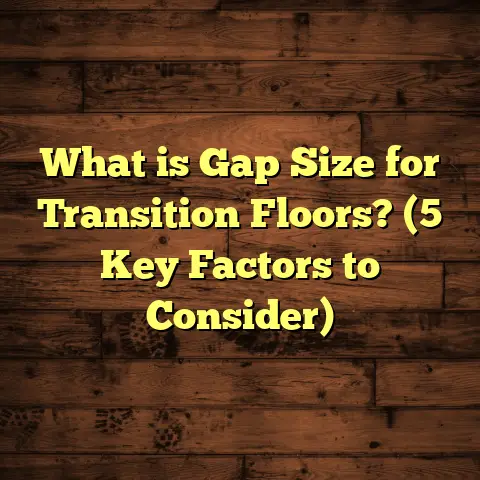What is Acceptable Gapping in Bamboo Flooring? (5 Key Factors to Consider)
When I think about flooring, the first thing that comes to mind is getting the best value for money. After all, flooring isn’t just about looks; it’s an investment that should last years, if not decades. That’s why when I started working with bamboo flooring, one of the biggest questions I faced—and still get asked—is about gapping. How much gap is acceptable in bamboo flooring? And why does it even matter?
Let’s break this down together.
What is Acceptable Gapping in Bamboo Flooring?
So, what is gapping exactly? Gapping refers to the small spaces or gaps that can appear between individual bamboo planks once they are installed. You might notice these gaps running parallel along the floorboards. They can be barely visible or quite noticeable, depending on several factors.
These gaps happen because wood and bamboo are natural materials reacting to changes in temperature and humidity. When the air gets dry, the material can shrink slightly, creating gaps. When it’s humid, the planks might expand and push closer together.
Acceptable gapping means the amount of space between planks that won’t affect the floor’s durability, appearance, or performance over time. Too much gap—well beyond what’s normal—can lead to problems like moisture damage or tripping hazards. Too little room for expansion can cause buckling.
I remember one job a few years ago where the homeowner was concerned about small gaps appearing just weeks after installation. It turned out those gaps were within an acceptable range and would stabilize as the house settled into its typical humidity levels.
But how do you know what’s acceptable? I’ll walk you through five key factors I’ve learned that make all the difference.
1. Understanding Bamboo as a Material
Bamboo behaves differently than traditional hardwood or laminate flooring. It’s technically a grass but processed into solid planks that mimic hardwood flooring properties.
The Nature of Bamboo
Bamboo grows incredibly fast compared to hardwood trees, often reaching maturity in 3-5 years. This rapid growth makes bamboo a sustainable choice, but it also means its cellular structure is different.
- Bamboo fibers run longitudinally with a natural density that varies by species and processing.
- Manufacturers typically process bamboo into strand-woven, horizontal, or vertical grain planks.
Each type has distinct characteristics affecting stability and gapping:
- Strand-woven bamboo is the hardest and most dimensionally stable due to compressed fibers.
- Horizontal grain shows a more natural bamboo pattern but can be less stable.
- Vertical grain has a linear look but may react more to humidity changes.
Why does this matter for gapping?
Bamboo flooring expands and contracts with changes in moisture content, sometimes more noticeably than hardwood.
- The average expansion rate for bamboo is about 1-3% across its width, depending on environmental conditions.
- For example, a 5-inch wide plank might expand up to 0.15 inches (3.8 mm).
This means even tiny changes in humidity can create visible gaps or tight joints.
From my experience, knowing this helps set realistic expectations right from the start. I always tell clients: expect some movement, especially in climates with large seasonal swings.
Personal Experience: When Bamboo Surprises You
Once, I installed strand-woven bamboo in a mountain cabin where temperatures dropped dramatically overnight. The owner was worried about the floor cracking or warping. Surprisingly, the floor performed very well compared to oak floors I had installed nearby years before. The dense strand-woven boards showed less gapping and fewer visible changes.
This taught me that choosing the right type of bamboo plank can influence acceptable gapping significantly.
2. Environmental Conditions: Humidity & Temperature
One of the biggest influences on gapping is the environment where the bamboo floor is installed.
What’s happening here?
Bamboo reacts to moisture in the air. In dry winter months, floors shrink; in humid summers, they expand.
- Ideal indoor humidity for bamboo flooring is between 40-60%.
- If humidity drops below 30% or rises above 70%, gapping or cupping becomes more likely.
I’ve worked in homes with poor climate control where gaps of up to 1/8 inch appeared in winter—completely normal but alarming to homeowners who weren’t prepared.
Seasonal Changes and Their Impact
The seasonal swings in temperature and humidity are often underestimated. Here’s what typically happens through the year:
| Season | Humidity Range (%) | Typical Floor Behavior |
|---|---|---|
| Winter | 20-40 | Shrinks; gaps appear |
| Spring | 40-60 | Stabilizes |
| Summer | 50-70+ | Expands; gaps close |
| Fall | 40-60 | Stabilizes |
In my experience, floors installed in summer may appear tighter initially but develop gaps as heating systems dry indoor air in winter.
Practical Tips for Managing Environment
- Use humidifiers during dry seasons.
- Maintain consistent room temperatures.
- Avoid extreme temperature swings by insulating well.
- Ensure proper acclimation of bamboo planks before installation—usually 3-7 days inside the home.
In one project, I advised a family to monitor their home’s humidity for a month before installation. Their data showed swings from 25% to 65%. We adjusted their HVAC settings and installed a humidifier, which made a huge difference in reducing post-installation gaps.
3. Installation Techniques and Subfloor Preparation
How bamboo flooring is installed plays a major role in gapping tolerance.
Acclimation: The Unsung Hero
Acclimation involves letting bamboo planks sit in the installation environment for several days so they can adjust to local temperature and moisture levels.
- Skipping acclimation increases risk of excessive gapping.
- Recommended acclimation time ranges from 48 hours to 7 days, depending on product and climate.
From my experience, giving boards at least 4 days indoors makes a huge difference in minimizing gaps later on.
Expansion Gaps: Room to Breathe
Leaving an expansion gap around the perimeter of the room (usually about 1/4 inch) prevents boards from pushing against walls as they expand.
- Without this space, floors can buckle or warp.
- Baseboards or quarter-round molding cover this gap afterward.
I once had a job where no expansion gap was left behind cabinets. The boards pushed up after summer heat, causing visible buckling that required partial removal and reinstallation.
Subfloor Preparation: Foundation of Stability
A level, dry subfloor ensures even support for bamboo planks.
- Uneven subfloors cause uneven pressure points leading to gaps or squeaks.
- Moisture barriers are essential over concrete slabs to prevent water vapor from damaging bamboo.
Checking subfloor moisture content before installation is critical:
- Wood subfloor moisture below 12% is usually safe.
- Concrete slabs should have moisture vapor emissions below 3 lbs/1000 sq ft/24 hr (calcium chloride test).
I’ve seen many installations fail early because contractors ignored these basics. One project had persistent large gaps until we replaced a damp subfloor underlayment.
4. Measuring & Defining Acceptable Gapping Standards
You might wonder: how much gap is really okay?
Industry standards give some guidance:
- The National Wood Flooring Association (NWFA) suggests gaps up to 1/16 inch (1.6 mm) are acceptable under normal conditions.
- For bamboo specifically, many manufacturers recommend no more than 1/32 inch (0.8 mm) between planks after acclimation.
- Anything larger than 1/8 inch (3 mm) typically signals an issue that should be addressed.
Why such small measurements?
Gaps smaller than 1/16 inch are usually invisible unless you’re looking closely or your floor has dark stains that highlight edges.
Larger gaps may:
- Collect dirt and debris.
- Create tripping hazards.
- Allow moisture penetration causing damage.
How do I measure?
I use feeler gauges and digital calipers during inspection to check plank spacing at various points—centers of rooms, near doorways, around expansion joints.
In one of my projects, we measured gaps at different points:
| Location | Gap Size (mm) | Acceptable? |
|---|---|---|
| Center of Room | 0.5 | Yes |
| Near Doorways | 1.2 | Borderline |
| Along Expansion Gap | 3+ | Intended |
Those near doorways were slightly larger due to traffic stress but still within acceptable limits given conditions.
When is gapping a problem?
If you notice:
- Gaps suddenly increasing beyond recommended sizes.
- Gaps accompanied by floor buckling or squeaking.
- Boards lifting or lifting edges near gaps.
These signs indicate underlying issues like improper installation or environmental extremes that need fixing fast.
5. Long-Term Maintenance and Monitoring
Acceptable gapping isn’t just about installation day—it’s about how floors behave over years.
I always tell clients: keep an eye on your floor’s condition seasonally.
What should you look for?
- Gaps that widen suddenly or drastically.
- Buckling or lifting boards.
- Moisture damage signs like discoloration near gaps.
Regular cleaning and maintaining indoor humidity help keep gapping stable.
My Ongoing Case Study
In one case study I tracked over five years, a home with bamboo flooring maintained at constant humidity showed less than 0.5 mm gap fluctuations annually—a testament to proper care.
Conversely, another home with fluctuating humidity experienced gaps growing beyond 2 mm each winter until humidifiers were installed and maintained regularly.
Maintenance Tips
- Clean spills immediately to avoid water damage near seams.
- Use soft brooms or vacuums with hardwood floor attachments.
- Avoid harsh chemicals that degrade finish or wood fibers.
- Monitor indoor humidity using simple hygrometers available online for $10-$30.
Bonus Insights From My Flooring Projects
I want to share some stories and lessons learned that might help you if you’re planning your own bamboo flooring installation:
Case Study: High Humidity Coastal Home
I once worked on a beach house where humidity often reached above 70%. Initially, large plank expansions caused buckling near doorways and closets.
By installing dehumidifiers and adjusting HVAC settings to maintain consistent indoor climate, we reduced problems dramatically within six months. The key was patience—allowing floors to acclimate fully while managing environment carefully.
Case Study: DIY Installer’s Surprise
A DIY enthusiast friend installed bamboo flooring without acclimating material properly during a dry winter month. He was frustrated when noticeable gaps appeared soon after installation.
I helped him sand down edges slightly and fill larger gaps with color-matched wood filler designed for bamboo floors. He also added humidifiers during winter months and saw improvement over time.
What About Different Types of Bamboo Flooring?
Not all bamboo flooring behaves identically regarding gapping.
Solid vs Engineered Bamboo Flooring
- Solid Bamboo Flooring: Entire plank is bamboo; more susceptible to moisture changes.
- Engineered Bamboo Flooring: Bamboo veneer over plywood core; generally more dimensionally stable due to cross-layer construction.
For rooms with fluctuating humidity (like basements), engineered bamboo may reduce gapping issues significantly.
How Does Climate Affect Your Choice?
Where you live changes everything about acceptable gapping:
| Climate Type | Expected Bamboo Behavior | Installation Tips |
|---|---|---|
| Dry/Arid | Higher shrinkage; larger gaps | Use humidifiers; longer acclimation |
| Humid/Tropical | Expansion common; tight joints | Leave larger expansion gaps; dehumidify |
| Temperate | Moderate movement | Follow standard guidelines |
| Seasonal Extremes | Wider swings possible | Monitor environment closely; adjust HVAC |
Tools & Technology for Monitoring Gapping
Technology has made monitoring easier than ever:
- Digital calipers and feeler gauges help measure small gaps precisely.
- Hygrometers track real-time humidity data.
- Apps connected to smart thermostats let you adjust indoor climate remotely.
I recommend clients invest in at least basic tools—they help catch problems early before damage happens.
Final Thoughts: Is Some Gapping Inevitable?
Yes! The honest truth is some gapping will happen with any natural material flooring like bamboo. The goal is controlling it so it doesn’t affect your floor’s beauty or safety.
When I install bamboo floors, I treat gapping not as a flaw but part of the floor’s natural character—as long as it stays within manageable limits.
If you’re thinking about bamboo flooring or dealing with gapping issues, ask yourself:
- How stable is my home’s humidity?
- Was the flooring acclimated properly?
- Are gaps within recommended sizes?
- Is my subfloor level and dry?
Answering these will help you decide whether your floor’s gapping is within acceptable limits or if action is needed.
Feel free to ask if you want advice on specific situations—I’ve seen just about every kind of gap problem out there and would be happy to help!





